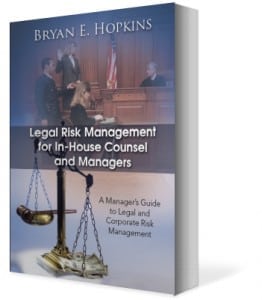 Organizations always hope for sunny skies and calm seas when conducting business. No one wants to be unpleasantly surprised nor exposed to rough weather, especially if such weather causes a person or an organizations' reputation, financial well being or its very existence to be threatened. However, in the past decade, due to many well publicized scandals involving companies, officers and directors, the study and implementation of risk management has become popular. People are discussing risk management more than ever.Organizations failing to manage risk have been subjected to government investigations, penalties and fines and of course the wrath of juries and the legal system in the US and elsewhere. Though some in the business of risk management often mention the term Enterprise Risk Management ("ERM") when discussing or referring to risk management, it is my opinion that in reality risk management is primarily a process to reduce and minimize legal risk such as minimizing exposure to class actions, product liability claims, lawsuits and government investigations. Hence it is really Legal Risk Management ("LRM") everyone should be concerned with-i.e., the management of legal risk and legal exposure.
Organizations always hope for sunny skies and calm seas when conducting business. No one wants to be unpleasantly surprised nor exposed to rough weather, especially if such weather causes a person or an organizations' reputation, financial well being or its very existence to be threatened. However, in the past decade, due to many well publicized scandals involving companies, officers and directors, the study and implementation of risk management has become popular. People are discussing risk management more than ever.Organizations failing to manage risk have been subjected to government investigations, penalties and fines and of course the wrath of juries and the legal system in the US and elsewhere. Though some in the business of risk management often mention the term Enterprise Risk Management ("ERM") when discussing or referring to risk management, it is my opinion that in reality risk management is primarily a process to reduce and minimize legal risk such as minimizing exposure to class actions, product liability claims, lawsuits and government investigations. Hence it is really Legal Risk Management ("LRM") everyone should be concerned with-i.e., the management of legal risk and legal exposure.
The principle role of in-house counsel in any organization is of course to mitigate legal risk in connection with the sale of products or services provided by the company. In essence, how the company or organization protects its success will be based in part on its ability to manage and control legal risk in the global marketplace. A company can be quite successful- its sales can increase on an exponential basis. But, if a LRM Program is not put into place, massive lawsuits, class actions and government fines and penalties can offset any gains and profits generated by sales. Legal counsel must take an active effort in developing strategies, systems and processes that will minimize legal exposure his or her organization faces. But it doesn’t stop there.
In order for LRM to be successful in any organization, the organization’s management must be involved. It is hoped that managers, executives and company personnel will also take an interest in this vital area. A successful LRM Program greatly depends on executive ownership of risk management. Only with the buy in of executive management will LRM be embedded in the processes of the organization.It is hoped therefore, that this blog, will foster discussion of issues surrounding Legal Risk Management not only from a legal point of view but also from a managerial point of view. In the future I will explore various processes and activities that I have developed through my experience to minimize, manage and control legal risk.
So, this blog post hopes to encourage a full and frank discussion of all the issues facing organizations, corporations or companies, the' management of those entities and/or in house counsel and external advisers when dealing with LRM and of course ERM. What are the concerns facing those involved with risk management? What are best practices when dealing with risk management? What systems, processes, procedures and tools are needed to form a viable effective LRM Program? How does an organization effectively minimize and control legal risk or its legal exposure? The more successful companies and organizations will be proactive when it comes to legal risk. The most competitive companies will in fact drive Legal Risk Management and will constantly seek to reduce or minimize the risk of legal exposure while competing in the global marketplace.
So lets discuss LRM and all of the issues raised by its implementation. I hope everyone finds it interesting.